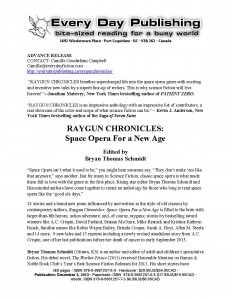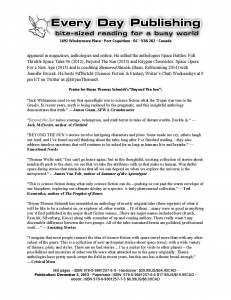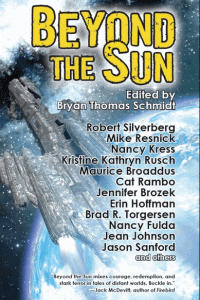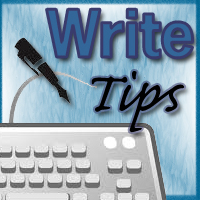Okay, it’s been a few months since I did one of these. I’ll admit, my well was running dry and needed a break to refresh. But I’m going to pick it back up now with a subject that many authors and even small publishers might benefit from: creating releases to go with review copies as you send them out.
If you’re not on a list to receive ARCS from majors, you may not have seen one. But all ARCs (Advanced Review Copies) come with a press release containing key information about the book. They are easy to create. I did mine in Word. And yet, they entice the recipient to read as well as making it easy for them to find key information about the author and book in case they want to write reviews, do interviews, or more.
I recently made these for my latest anthologies and here’s what they look like for Raygun Chronicles:


So let’s break it down. First, your header should include the publisher’s logo and primary business address.
The footer should include the meta data about the book (as shown), including page count, release date, sale price, ISBN, format, etc.
360 pages · ISBN 978-0-9881257-5-9 · Hardcover: $29.95US/$34.95CAD ·
Publication: December 3, 2013 · Paperback: ISBN 978-0-9881257-6-6 $17.95US/$19.95CAD ·
ebook: ISBN 978-0-9881257-7-3 $6.99US/$8.99CAD
Usually centered. This is the key information for both reviews and articles as well as booksellers and others who might want to order the book.
The header and footer should be the same on every page of the release. And I should tell you, two pages is usually more than enough. In fact, most are a page and a half.
Now let’s look at what lies between.
First, at the top right corner, put contact information. An email address, name hyperlink and even phone number if you want, usually for a publicist or publisher who will serve as key point of contact for inquiries about the book. Sometimes the release date is also included in bold above this information.
Next, key quotes. If you’re fortunate enough to have early reviews or blurbs back, use them. If they’re too long, trim or use judicious ellipses, but don’t change the meaning of anything. This is very important. You will be called on it and having those kinds of questions raised in the middle of a release is not advisable. It’s an unneeded distraction at the least.
Then, centered, in large text and bold, Title and author’s name as a reminder which book this release pertains to. After all, most reviewers and interviewers get many ARCs and releases and they can be easily separated and all look alike. Make it easy for them to be matched up again if necessary.
Then a brief summary about the book, using your best exciting, sales language, of course, to make them want to read.
This should be followed by a bio of the author. 100-150 words should suffice. Less if possible. Concise and quick is what matters here. You want to excite and tease them but not make them stop reading.
Then after the bio, usually on page 2 (as shown) include blurb clips from author’s previous work. Sometimes there can be images of the book, but these increase printing cost. Often a list of the author’s other titles with ISBNs and prices is included.
Regardless, this is the standard information for such releases. The purpose is to get the recipient to prioritize attention to the book in question. And so keep it concise, clean, and positive. But also be honest and don’t overdo it. After all, the book should speak for itself. Remember, with all the requests inundating them and the fact that not every book, subject or author appeals to everyone, your book may not be chosen. Sometimes they’ve reviewed too much in that genre recently or even an0ther of your books. Sometimes, there are other reasons. Regardless, getting it into their hands and getting their attention is your job. What happens after that is not.
Printing these double sided is a good idea, but stapled double pages is also common. Regardless, they are easy to make and cheap to print and they will make even your self-published or micropress book look professional alongside the books from the majors. Provided your cover design and layout can compete, that is. But that’s a different post.
So that’s how to make your own professional Release Cover Letters For Review Copies of your books. I hope it’s useful. For what it’s worth…
 Bryan Thomas Schmidt is an author and editor of adult and children’s speculative fiction including the novels The Worker Prince and The Returning, and the children’s books 102 More Hilarious Dinosaur Jokes For Kids (ebook only) and Abraham Lincoln: Dinosaur Hunter- Land Of Legends. His debut novel, The Worker Prince (2011) received Honorable Mention on Barnes & Noble Book Club’s Year’s Best Science Fiction Releases for 2011. His short stories have appeared in magazines, anthologies and online. He edited the anthologies Space Battles: Full Throttle Space Tales #6 (Flying Pen Press, 2012), Beyond The Sun (Fairwood, July 2013), and Raygun Chronicles: Space Opera For a New Age (Every Day Publishing, November 2013) and is working on Shattered Shields with co-editor Jennifer Brozek (Baen, 2014). He also hosts #sffwrtcht (Science Fiction & Fantasy Writer’s Chat) Wednesdays at 9 pm ET on Twitter and can be found via Twitter as @BryanThomasS, on his website atwww.bryanthomasschmidt.net or Facebook.
Bryan Thomas Schmidt is an author and editor of adult and children’s speculative fiction including the novels The Worker Prince and The Returning, and the children’s books 102 More Hilarious Dinosaur Jokes For Kids (ebook only) and Abraham Lincoln: Dinosaur Hunter- Land Of Legends. His debut novel, The Worker Prince (2011) received Honorable Mention on Barnes & Noble Book Club’s Year’s Best Science Fiction Releases for 2011. His short stories have appeared in magazines, anthologies and online. He edited the anthologies Space Battles: Full Throttle Space Tales #6 (Flying Pen Press, 2012), Beyond The Sun (Fairwood, July 2013), and Raygun Chronicles: Space Opera For a New Age (Every Day Publishing, November 2013) and is working on Shattered Shields with co-editor Jennifer Brozek (Baen, 2014). He also hosts #sffwrtcht (Science Fiction & Fantasy Writer’s Chat) Wednesdays at 9 pm ET on Twitter and can be found via Twitter as @BryanThomasS, on his website atwww.bryanthomasschmidt.net or Facebook.

